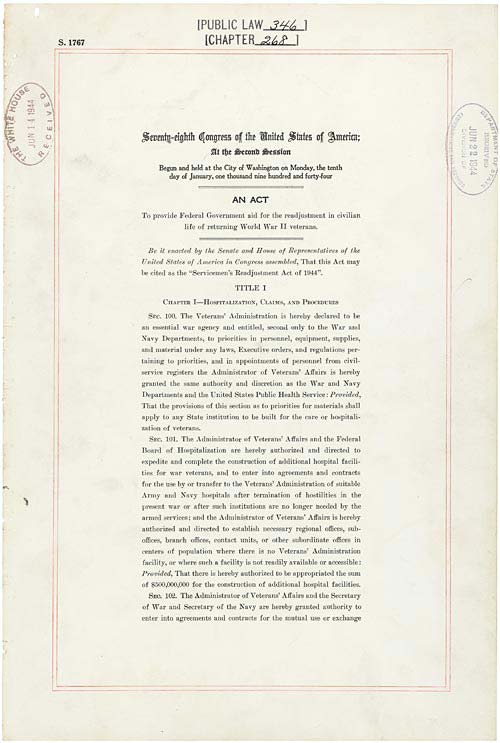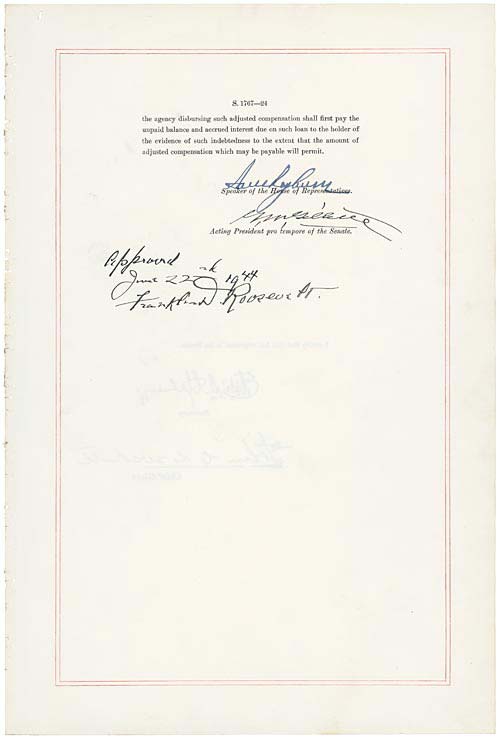 The Servicemen’s Readjustment Act, also known as the G.I. Bill, was signed into law by President Roosevelt, in June 22, 1944. The bill would offer veterans with funding for their college education, housing, and unemployment. The cash was provided to those veterans who were fighting during the Second World War, and funds were extracted from the funds set aside for battle.
The Servicemen’s Readjustment Act, also known as the G.I. Bill, was signed into law by President Roosevelt, in June 22, 1944. The bill would offer veterans with funding for their college education, housing, and unemployment. The cash was provided to those veterans who were fighting during the Second World War, and funds were extracted from the funds set aside for battle.
Unemployment
While WW2 was in effect, the department of labor had estimated that there would be around 15 million individuals (men and women) that would be unemployed, once the war ended.
The resources planning board, in order to prevent this widespread amount of unemployment and of financial difficulties, speculated what the post war manpower demand would be like and created a variety of programs and training for the end of 1942 and early 1943.
 The American Legion was in charge of laying out the content in the G.I. Bill, and what terms would be set forth for veterans; the bill was sent to congress, passed both houses, and was signed in to law by the President in 1944, only a few days after D-Day.
The American Legion was in charge of laying out the content in the G.I. Bill, and what terms would be set forth for veterans; the bill was sent to congress, passed both houses, and was signed in to law by the President in 1944, only a few days after D-Day.
Federal Aid
The Servicemen’s Readjustment Act was realized and was more well-known as the G.I. Bill of Rights. It provided federal aid for veterans who had fought in war. The bill was meant to aid the veterans to help them return and transition back in to civilian life as easily as possible, in areas from hospital bills, home purchases, business, and namely in the field of education.
The bill provided funding to help pay for books, financials for schooling, counseling, and any other financials, that were connected to getting an education, once they returned to civilian life, and decided to go back to get an education. For the following 7 years, about 2,300,000 individuals attended college, 3,500,000 received training from school, and about 3,400,000 received on the job training, thanks to the funding that was provided by the G.I. Bill. The number of bachelor degree granted was doubled from 1940 to 1950, and the number of individuals who had a college education jumped from just under 5 % up to around 25 % in only half a century since the Servicemen Act (the G.I. Bill) became law following the war.
Benefits Included
For veterans who did take advantage of the bill, there were quite a few opportunities, and there were several areas of financial assistance that they received, once returning home from the war, in an attempt to get back to civilian life as naturally as possible.
Some of the financial assistance offered included payment for college/schooling, discounts on mortgage rates for those who were going to buy a home, low interest rates for those who were interested in starting their own business, cash payments for living expenses related to college attendance, and a number of other unemployment compensation and benefits were offered, to the veterans who participated in the Bill.
Expiration
By the time period that it had expired, the portion that covered for education and for training had paid out around $14.5 million to those who had selected to return to school, and to receive an education, in order to get proper training, for new careers, following the return to civilian life.
Although this number was quite high, estimates showed that with the increase from the federal tax returns would quickly repay this amount, many times over, and would circulate the money that was spent, back in to the economy, just as quickly as it was paid out.
By the time 1955 rolled around, it was also estimated that there were about 4.3 million home loans granted to these veterans because of the bill, and that these total amounts were around $33 million for the outstanding loan totals following the post war period.
Veteran Contribution
It was estimated that veterans were responsible for the purchase of around 20% of new homes that were being sold during this period and for several years following the signing of the Servicemen Bill into law. This also reflected in other areas of the country’s economy, and instead of a post-war economic depression, only prosperity thrived. The great returns were because of the finances to veterans who had come home from the war who needed to readjust to civilian life.
Extension of the Bill
Over the years, the bill was extended countless times, and it had been taken advantage of by many war veterans, namely those who decided to go back to school, receive training for work, and get an education after returning from war. Millions of veterans have taken part in the program, and millions of dollars have been displaced for these individuals throughout the year, and following several wars, not only WW2.
There were around 2.3 million Americans who used the funding during the Korean War alone, and received financial assistance once they returned home and to their families after the war. During the Vietnam War, around 8 million Americans decided to use the resources, and received the same type of funding for schooling, home purchases, return to civilian life, and other aspects of their life.
Post 9/11
Although the G.I. Bill program ended in 1956, the government reestablished G.I. Bill 2.0, to offer assistance for certain military personnel, in certain positions. The National Guard and certain reserves are eligible for the bill. Some of the assistance offered includes subsidies for home purchases, part time on the job training, a stipend for distance learning, and financial assistance for those who are planning on returning to school.
There were millions who were helped under the original bill, and many more have been helped under the 2.0 bill which took effect following 9/11. The G.I. Bill was an attempt to offer veterans as easy a transition back in to civilian life following the war, and an attempt to help build on new work, businesses, and trained professionals, through the financing that was provided for schooling and on the job training.